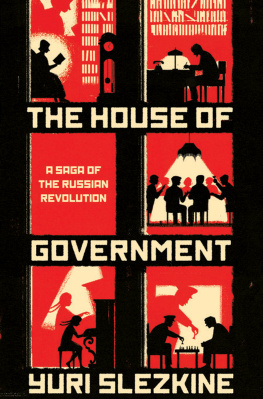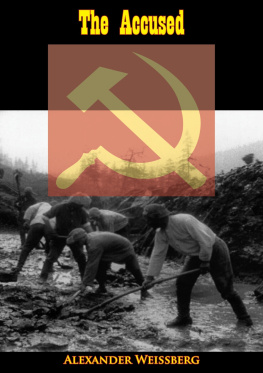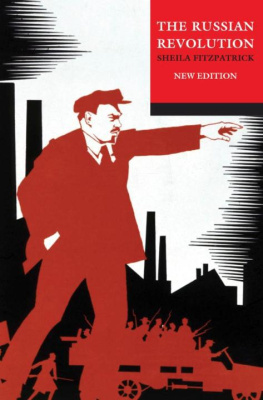
THE HOUSE OF GOVERNMENT

The House of Government.
(Courtesy of the House on the Embankment Museum, Moscow.)
THE HOUSE OF GOVERNMENT
A SAGA OF THE RUSSIAN REVOLUTION
YURI SLEZKINE
PRINCETON UNIVERSITY PRESS
PRINCETON AND OXFORD
Copyright 2017 by Yuri Slezkine
Requests for permission to reproduce material from this work should be sent to Permissions, Princeton University Press
Published by Princeton University Press
41 William Street, Princeton, New Jersey 08540
In the United Kingdom: Princeton University Press
6 Oxford Street, Woodstock, Oxfordshire OX20 1TR
press.princeton.edu
Jacket illustration by Francesco Bongiorni / Marlena Agency
Jacket design by Chris Ferrante
Unless otherwise noted in the caption, all images are courtesy of the House on the Embankment Museum.
All Rights Reserved
Library of Congress Cataloging-in-Publication Data
Names: Slezkine, Yuri, 1956- author.
Title: The House of Government : a saga of the Russian Revolution / Yuri Slezkine.
Description: Princeton : Princeton University Press, 2017.
Identifiers: LCCN 2016049071 | ISBN 9780691176949 (hardcover : acid-free paper)
Subjects: LCSH: Moscow (Russia)Politics and government20th century. | CommunistsRussia (Federation)MoscowBiography. | Apartment dwellersRussia (Federation)MoscowBiography. | Victims of state-sponsored terrorismRussia (Federation)MoscowBiography. | Moscow (Russia)Biography. | Apartment housesRussia (Federation)MoscowHistory20th century. | Moscow (Russia)Buildings, structures, etc. | Political purgesSoviet UnionHistory. | State-sponsored terrorismSoviet UnionHistory. | Soviet UnionPolitics and government19361953. | BISAC: HISTORY / Europe / Russia & the Former Soviet Union. | HISTORY / Revolutionary. | HISTORY / Social History. | POLITICAL SCIENCE / Political Ideologies / Communism & Socialism.
Classification: LCC DK601 .S57 2017 | DDC 947.084/10922dc23 LC record available at https://lccn.loc.gov/2016049071
British Library Cataloging-in-Publication Data is available
This book has been composed in Kazimir Text and Kremlin II Pro
Printed on acid-free paper.
Printed in the United States of America
10 9 8 7 6 5 4 3 2 1
This is a work of history. Any resemblance to fictional characters, dead or alive, is entirely coincidental.
Sometimes it seemed to Valne that time had come to a stop, suspended and frozen around an expectation he could not define. The very idea of his projected tableau, whose exposed, fragmented images had begun to haunt every second of his life, furnishing his dreams and ordering his memories; the very idea of this eviscerated building laying bare the cracks of its past and the crumbling of its present; this haphazard piling up of stories grandiose and trivial, frivolous and pathetic, made him think of a grotesque mausoleum erected in memory of companions petrified in terminal poses equally insignificant in their solemnity and banality, as if he had wanted to both prevent and delay these slow or quick deaths that seemed to engulf the entire building, story by story: Monsieur Marcia, Madame Moreau, Madame de Beaumont, Bartlebooth, Rorschash, Mademoiselle Crespi, Madame Albin, Smautf. And him, of course, Valne himself, the houses oldest inhabitant.
GEORGES PEREC, LIFE: A USERS MANUAL
Mephisto:
There lies the body; if the soul would fly away,
I shall confront it with the blood-signed scroll.
Alas, they have so many means today
To rob the Devil of a soul.
JOHANN WOLFGANG VON GOETHE, FAUST,
TRANS. WALTER KAUFMANN
CONTENTS
PREFACE
During the First Five-Year Plan (192832), the Soviet government built a new socialist state and a fully nationalized economy. At the same time, it built a house for itself. The House of Government was located in a low-lying area called the Swamp, across the Moskva River from the Kremlin. The largest residential building in Europe, it consisted of eleven units of varying heights organized around three interconnected courtyards, each one with its own fountain.
It was conceived as a historic compromise and a structure of the transitional type. Halfway between revolutionary avant-garde and socialist realism, it combined clean, straight lines and a transparent design with massive bulk and a solemn neoclassical facade. Halfway between bourgeois individualism and communist collectivism, it combined 505 fully furnished family apartments with public spaces, including a cafeteria, grocery store, walk-in clinic, child-care center, hairdressers salon, post office, telegraph, bank, gym, laundry, library, tennis court, and several dozen rooms for various activities (from billiards and target shooting to painting and orchestra rehearsals). Anchoring the ensemble were the State New Theater for 1,300 spectators on the riverfront and the Shock Worker movie theater for 1,500 spectators near the Drainage Canal.
Sharing these facilities, raising their families, employing maids and governesses, and moving from apartment to apartment to keep up with promotions were peoples commissars, deputy commissars, Red Army commanders, Marxist scholars, Gulag officials, industrial managers, foreign communists, socialist-realist writers, record-breaking Stakhanovites (including Aleksei Stakhanov himself) and assorted worthies, including Lenins secretary and Stalins relatives. (Stalin himself remained across the river in the Kremlin.)
In 1935, the House of Government had 2,655 registered tenants. About 700 of them were state and Party officials assigned to particular apartments; most of the rest were their dependents, including 588 children. Serving the residents and maintaining the building were between six hundred and eight hundred waiters, painters, gardeners, plumbers, janitors, laundresses, floor polishers, and other House of Government employees (including fifty-seven administrators). It was the vanguards backyard; a fortress protected by metal gates and armed guards; a dormitory where state officials lived as husbands, wives, parents, and neighbors; a place where revolutionaries came home and the revolution came to die.
In the 1930s and 1940s, about eight hundred House residents and an unspecified number of employees were evicted from their apartments and accused of duplicity, degeneracy, counterrevolutionary activity, or general unreliability. They were all found guilty, one way or another. Three hundred forty-four residents are known to have been shot; the rest were sentenced to various forms of imprisonment. In October 1941, as the Nazis approached Moscow, the remaining residents were evacuated. When they returned, they found many new neighbors, but not many top officials. The House was still there, but it was no longer of Government.
It is still there today, repainted and repopulated. The theater, cinema, and grocery store are in their original locations. One of the apartments is now a museum; the rest are private residencies. Most private residencies contain family archives. The square in front of the building is once again called Swamp Square.
This book consists of three strains. The first is a family saga involving numerous named and unnamed residents of the House of Government. Readers are urged to think of them as characters in an epic or people in their own lives: some we see and soon forget, some we may or may not recognize (or care to look up), some we are able to identify but do not know much about, and some we know fairly well and are pleased or annoyed to see again. Unlike characters in most epics or people in our own lives, however, no family or individual is indispensable to the story. Only the House of Government is.
Next page












